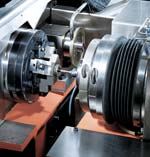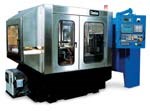Internal Grinding Spindle Listens To See
This company has taken the use of acoustical technology for grinding machines in a different direction. It has placed a wide frequency acoustic sensor directly into the high frequency spindle of an internal grinder.
Share




Setting up an internal grind for complex bores or threads is a time consuming activity. Shops all across metalworking are looking for ways to reduce the non-metal cutting time.
Bore grinding and internal thread grinding are especially challenging because the machinist must be skilled and careful when locating internal features. Unlike OD grinding, ID work is generally done blind because the operator is unable to see the actual grinding wheel to part contact.
For some time now, grinding machine manufacturers have used acoustic sensors to determine wheel to work contact. These systems are generally referred to as "gap eliminators" because they reduce the amount of air grinding time when approaching the part.
Drake Manufacturing (Warren, Ohio) has taken this use of acoustical technology in a different direction. It has placed a wide frequency acoustic sensor directly into the high frequency spindle of an internal grinder.
Called Smart Spindle, this system effectively automates the traditional touch method of setting up ID grinding. The company says using this technology can reduce setup time on internally ground parts by as much as 90 percent.
Acoustic emission technology works by sensing the difference in sound between a cutting and non-cutting event, with varying degrees based on acoustical signatures and digital filtering. Once a wheel touches a workpiece, the sound triggers an immediate CNC response.
In this way, the system works as an automatic detector and, because the sensor is located in the grinding wheel spindle, the wheel itself, in effect, becomes a probe capable of locating internal part features. The sensor also serves double duty by providing touch sensing during the dressing cycle. The sub-micron sensitivity of the system keeps the amount of dressed material to a minimum and makes sure the entire wheel surface is optimally dressed.
Key to making this system practical is the software developed to process the data. It uses signals from the acoustical sensors, in both the grinding and dressing modes, to make "smart" decisions. Drake calls this software programming package Part Smart.
It is pre-program menu entry, application specific software coupled with million-count servo encoders and glass scales for positioning feedback—with resolution of 4 millionths of an inch—all designed for quick response processing of the acoustical data.
An interim step in the development of the Smart Spindle technology was acoustic touch dressing capability. It featured a sensor equipped wheel dresser system capable of detecting the sound of the superabrasive wheel contacting the diamond roll during dress.
The touch dress provided precise control of the entire dress process and eliminated guesswork as to how much material to remove, which saves precious superabrasive material. It was the touch dress capability that was refined into the Smart Spindle package using acoustic sensor technology in the grinding spindle and integrating it with the CNC and machine movement.
Related Content
-
Lean Approach to Automated Machine Tending Delivers Quicker Paths to Success
Almost any shop can automate at least some of its production, even in low-volume, high-mix applications. The key to getting started is finding the simplest solutions that fit your requirements. It helps to work with an automation partner that understands your needs.
-
The Future of High Feed Milling in Modern Manufacturing
Achieve higher metal removal rates and enhanced predictability with ISCAR’s advanced high-feed milling tools — optimized for today’s competitive global market.
-
Inside the Premium Machine Shop Making Fasteners
AMPG can’t help but take risks — its management doesn’t know how to run machines. But these risks have enabled it to become a runaway success in its market.



























.jpg;maxWidth=970;quality=90)